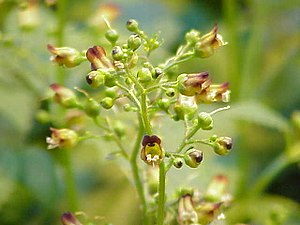Gnarled figwort
| Gnarled figwort | ||||||||||||
|---|---|---|---|---|---|---|---|---|---|---|---|---|

Gnarled figwort ( Scrophularia nodosa ) |
||||||||||||
| Systematics | ||||||||||||
|
||||||||||||
| Scientific name | ||||||||||||
| Scrophularia nodosa | ||||||||||||
| L. |
The figwort or figwort ( Scrophularia nodosa ) is the most common representative of the genus of figwort ( Scrophularia ) in Central Europe .
description
It is a perennial herbaceous plant that reaches heights of between 50 and 100 centimeters. The name gnarled figwort refers on the one hand to the knotty swellings of the rhizome on the surface and on the other to the brown flowers of the plant.
The plant has an upright stem , which usually only branches in the inflorescence . It is sharp, square, at the height of the inflorescence also with more pronounced edges, but is not winged .
The leaves are undivided or at most at the base with one or two small side lobes. Its edge is sawn twice.
The flowers are in terminal panicle-like thyrses . The crown is brown-red in front, more greenish at the bottom. The sepals are rounded at the front and often have narrow, skinned edges. Otherwise, the structure of the flowers corresponds exactly to the scheme described in the article about the brown wort.
The species chromosome number is 2n = 36.
ecology
The gnarled figwort is a hemicryptophyte and stem plant.
The flowers are pre-female "throat flowers". First appearing scar on the crown entrance, you'll see the same place the four successively ripening anthers . The female and male phases each last two days. Pollinators are bees and wasps , especially wasps ; So it is a wasp flower. The pollination occurs abdominal side. In North America, where the species is naturalized, hummingbirds have also been observed as pollinators. Finally, self-pollination is possible. The flowering period is from June to July.
The capsule fruit is formed from 2 carpels; it opens up with crevices in the wall when it is dry. The small seeds are up to 1 mm long and weigh only 0.08 mg. They spread out as grain fliers. Since the fruit stalk is elastic and lignified, it is also possible to spread seeds as a wind and animal spreader as well as to spread the seeds. The seeds are cold germs . Fruit ripening is from August to October.
Vegetative reproduction after flowering takes place through underground runners .
distribution
The gnarled figwort occurs in Europe and in western Asia to the Caucasus and eastern Siberia. It was introduced into eastern North America.
It grows in moderately nutrient-rich, moist places in forests, on the edges of forests, in bushes or on river banks. In Central Europe it is a weak species of the Fagetalia sylvaticae societies, but also occurs in societies of the associations Alliarion, Aegopodion or the class of flares (Epilobietea angustifolii). In the Allgäu Alps, it rises to the Hirschalpe near Hindelang in Bavaria up to 1460 m above sea level.
Others
The plant was used in folk medicine against a variety of ailments, for example against lymph gland swelling, against skin ailments and for wound healing, for throat diseases or as a diuretic.
Scrophularia nodosa is used as an active ingredient in homeopathic medicines. The ascribed effect especially against swellings, eczema and ulcers has not been scientifically confirmed.
photos
swell
literature
- Henning Haeupler, Thomas Muer: picture atlas of the fern and flowering plants of Germany . Ed .: Federal Agency for Nature Conservation (= The fern and flowering plants of Germany . Volume 2 ). Eugen Ulmer, Stuttgart (Hohenheim) 2000, ISBN 3-8001-3364-4 .
- Rudolf Schubert , Klaus Werner, Hermann Meusel (eds.): Excursion flora for the areas of the GDR and the FRG . Founded by Werner Rothmaler. 14th edition. tape 2 : vascular plants . People and knowledge, Berlin 1988, ISBN 3-06-012539-2 .
- Werner Rauh, Karlheinz Senghas: Flora of Germany and its adjacent areas. Founded by Otto Schmeil, Jost Fitschen. 84th edition. Quelle & Meyer, Heidelberg 1968.
Individual evidence
- ↑ Ruprecht Düll , Herfried Kutzelnigg : Pocket dictionary of plants in Germany. A botanical-ecological excursion companion to the most important species . 6th, completely revised edition. Quelle & Meyer, Wiebelsheim 2005, ISBN 3-494-01397-7 , p. 429 .
- ↑ a b Erich Oberdorfer : Plant-sociological excursion flora for Germany and neighboring areas . 8th edition. Stuttgart, Verlag Eugen Ulmer, 2001. Page 832. ISBN 3-8001-3131-5
- ↑ a b c Ruprecht Düll , Herfried Kutzelnigg : Pocket dictionary of plants in Germany and neighboring countries. The most common Central European species in portrait . 7th, corrected and enlarged edition. Quelle & Meyer, Wiebelsheim 2011, ISBN 978-3-494-01424-1 , p. 711-712 .
- ^ Scrophularia in the Germplasm Resources Information Network (GRIN), USDA , ARS , National Genetic Resources Program. National Germplasm Resources Laboratory, Beltsville, Maryland. Retrieved December 21, 2017.
- ↑ Erhard Dörr, Wolfgang Lippert : Flora of the Allgäu and its surroundings. Volume 2, IHW, Eching 2004, ISBN 3-930167-61-1 , p. 432.
- ↑ Pharmacy review: drug information on Lymphomyosot N drops ( memento of the original from 23 September 2015 in the Internet Archive ) Info: The archive link has been inserted automatically and has not yet been checked. Please check the original and archive link according to the instructions and then remove this notice.
Web links
- Gnarled figwort. In: FloraWeb.de.
- Gnarled figwort . In: BiolFlor, the database of biological-ecological characteristics of the flora of Germany.
- Scrophularia nodosa L. In: Info Flora , the national data and information center for Swiss flora .
- Distribution in the northern hemisphere from: Eric Hultén, Magnus Fries: Atlas of North European vascular plants. 1986, ISBN 3-87429-263-0 at Den virtuella floran. (swed.)
- Thomas Meyer: Braunwurz data sheet with identification key and photos at Flora-de: Flora von Deutschland (old name of the website: Flowers in Swabia )







